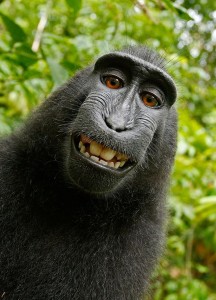There has been a lot of press recently about nature photographer David Slater’s claim of copyright in a “selfie” taken by a macaque monkey that picked up Slater’s camera and began snapping hundreds pictures. The selfie, taken by a crested black macaque (Macaca nigra) in an Indonesian forest in 2011, found its way to the Wikipedia Commons website.
To be copyrightable, a work must be the result of human authorship. Emile Borel’s infinite monkeys at infinite typewritters might create a Shakespeare play, but it would not be copyrightable, and neither is a macaque selfie.
Slater’s monkey business is an important reminder about the importance of authorship to the ownership of copyright rights. Works prepared by an employee in the scope of their employement are works made for hire, and the employer is considered the author and the owner of the work. However with the exception of certain specified types of works created pursuant to a prior written agreement, the owner of a copyrightable work is the author. This means that merely hiring and paying an independent contractor does not transfer ownership of the copyright in their work product, a critical lapse for someone who wants to modify (prepare derivatives of), or reproduce or distribute copies of, the work. It’s also important to remember that while co-author of a copyrighted work can generally do whatever he or she wants with the jointly created work, each co-author but has to account to the other co-owners for the use of the co-owned work, and not necessarily in proportion to the contributions of the co-authors.
Whenever a non-employee is engaged to create a work or contribute to a work, have a writen work-made-for-hire agreement (if appropriate), or an assignment. Otherwise you may not be able to do what you want with that work.

